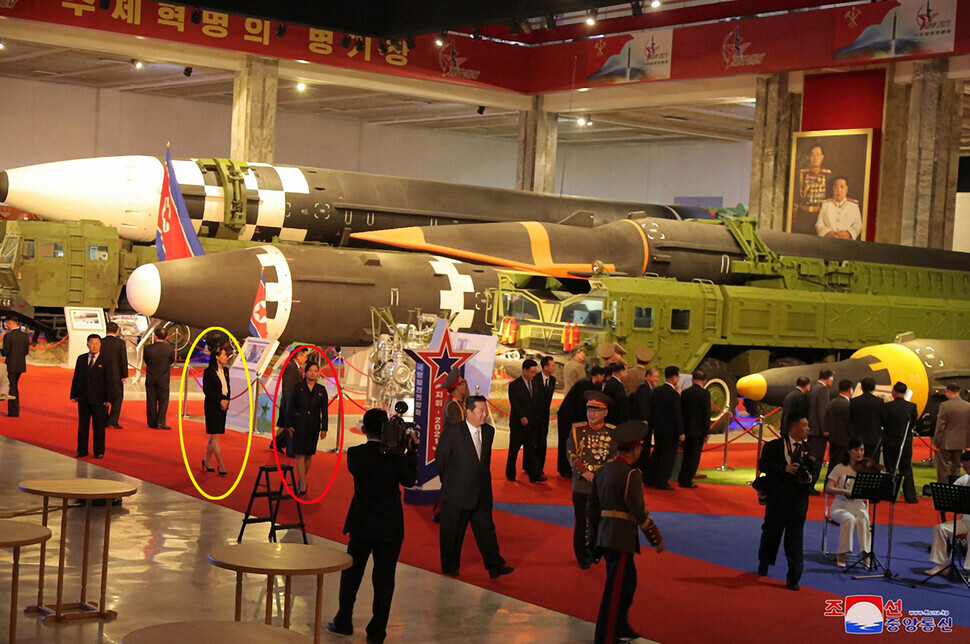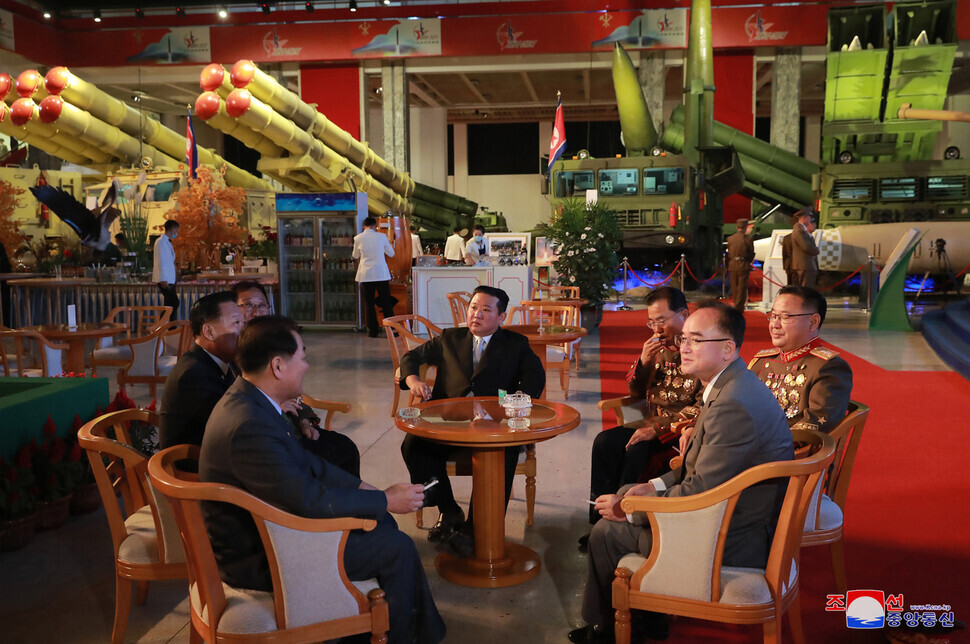hankyoreh
Links to other country sites 다른 나라 사이트 링크
[News analysis] How to interpret Kim Jong-un’s change in rhetoric

North Korean leader Kim Jong-un declared that North Korea’s “arch-enemy” is “war itself, not south Korea, the United States or any other specific state or forces,” the nation’s state-run Rodong Sinmun newspaper reported Tuesday.
His remarks came during a commemorative speech for the defense development exhibition “Self-Defence 2021,” which was held for the first time Monday at the Three Revolutions Exhibition museum in Pyongyang.
“Building up national defence is an indispensable and vital state affair which our Party, government and people must not neglect even a moment,” Kim said in his speech.
“Without strong self-defence capability we can neither expect successful progress of the internal and external policies of the Party and the government nor think about stability and peaceful environment of the country,” he added.
“We must be powerful also for our coming generations. This is our first and foremost task,” he said.
His remarks were notable for their references to South Korea and the US. In general terms, his public declaration that North Korea has no “arch-enemy” could be seen as reflecting the international practice of not identifying any particular country as a primary adversary.
In a more practical sense, it was noteworthy as a clear departure from the climate expressed in a previous speech by Kim at the Eighth Workers’ Party of Korea (WPK) Congress in January, where he referred to the US as the “fundamental obstacle to the development of our revolution and our principal enemy.”
Kim also said, “The dreadful history of having recourse to arms against the fellow countrymen must not be repeated on this land.”

Stressing that North Korea is “building up war deterrent true to the meaning of the words in order to prevent the war itself and to safeguard the sovereignty of our state,” he added, “I want to reiterate that south Korea is not the target of our armed forces.”
His remarks recall his summit with South Korean President Moon Jae-in and their pledge for “no more war” on the Korean Peninsula in their Panmunjom Declaration of April 27, 2018.
In short, his speech sent a public message to South Korea and the US that the aim of North Korea’s efforts to build military capabilities is defense rather than offense.
Whatever other intentions lay behind it, the change in rhetoric in a public setting could itself be seen as Kim’s version of a peace declaration, sending an important signal in terms of Pyongyang’s policies toward South Korea and others.
Along the same lines, his speech was notable for the absence of any reference to “nuclear weapons” or “nuclear deterrence” — previously considered the key element of the North’s nuclear capabilities — during his discussion of the tasks and outcomes of the “do-or-die revolution in the defence industry.”
The unprecedented format of a defense development exhibition also hinted at a change in Kim’s approach to governance, with ramifications in terms of how resources are prioritized.
The exhibition format is similar to the weapon shows and defense expositions that are held in many countries, including South Korea, the US, Japan, China, and Russia.
To begin with, it causes less of an issue internationally than the military parades held in the past at Kim Il-sung Square in Pyongyang, which were perceived by the outside world as belligerent. Most importantly, it allows the North to save a lot of money, staffing, and time in comparison with the large-scale parades.
Analysts saw this change in approach as reflecting Kim’s commitment to policies of channeling more resources toward “socialist construction” — named in Kim’s speech at the eight WPK Congress as a “great revolutionary undertaking” — and “solving the people's food, clothing and housing problems,” as mentioned in his commemorate speech for the WPK’s 76th anniversary.
The choice of “Self-Defence 2021” as a name also suggests the event could be held on a yearly basis. Referring to the exhibition as an “epoch-making demonstration of our national strength no less significant than a large-scale military parade,” Kim seemed to hint that the exhibitions could be used to replace or supplement military parades going forward.

But while the tenor of Kim’s references to South Korea and the US was softer than before, they were not completely amicable.
“Recently, the United States has frequently sent signals that it is not hostile to our state, but its behaviours provide us with no reason why we should believe in them,” he said.
Commenting that the US was “still generating regional tension with its wrong judgment and acts,” he added, “What is clear is that the instable situation in the region of the Korean peninsula cannot be easily removed because of the United States.”
His message reads as calling for action rather than words from Washington. It’s a reflection of Pyongyang’s position that the proverbial ball is in Washington’s court — with the North unlikely to take the first step when it comes to dialogue or negotiations with the US.
In a message directed at South Korea, Kim expressed “deep regret” over what it described as a “double-dealing, illogical and brigandish attitude.”
He accused Seoul of a “concentrated expression of their deeply-ingrained hostility towards our Republic,” noting its “attempt to modernize its armaments which has recently become intolerably undisguised,” its “[justifying] itself with the containment of our threat and defence of peace,” the “clear” objective of its efforts to “improve its missile capacity,” and its focus on “modernizing its strike weapons of various kinds.”
Kim also said that South Korean and US endeavors to strengthen their military capacity continue to “damage the inter-Korean feelings and emotions,” with the effect of “breaking the military equilibrium in the region of the Korean peninsula and aggravating the military instability and danger there.”
At the same time, he offered his assurance that “no tension will be caused on the Korean peninsula” — albeit on the condition that South Korea “does not find fault with us in a stubborn manner” or “pick a quarrel even with our exercise of national sovereignty.”
Kim’s remarks about South Korea and the US seemed to suggest that the risk of a rapid rise in the crisis level is low — but also that swift progress in inter-Korean or North Korea-US relations are unlikely to happen for the time being.
A South Korean Ministry of Unification official said, “We see this speech by Kim Jong-un as a reaffirmation of the main content and direction laid out in his Supreme People’s Assembly policy speech on Sept. 29.”
In that speech, Kim declared the restoration of the inter-Korean communication hotlines, while calling on South Korea to “keep the stand of national independence through practices, not with words,” to “deal with the inter-Korean relations with a view to settling the essential matters,” and to “give weight to and sincerely implement the north-south declarations.”
By Lee Je-hun, senior staff writer
Please direct questions or comments to [english@hani.co.kr]

Editorial・opinion
![[Editorial] Yoon must halt procurement of SM-3 interceptor missiles [Editorial] Yoon must halt procurement of SM-3 interceptor missiles](https://flexible.img.hani.co.kr/flexible/normal/500/300/imgdb/child/2024/0501/17145495551605_1717145495195344.jpg) [Editorial] Yoon must halt procurement of SM-3 interceptor missiles
[Editorial] Yoon must halt procurement of SM-3 interceptor missiles![[Guest essay] Maybe Korea’s rapid population decline is an opportunity, not a crisis [Guest essay] Maybe Korea’s rapid population decline is an opportunity, not a crisis](https://flexible.img.hani.co.kr/flexible/normal/500/300/imgdb/original/2024/0430/9417144634983596.jpg) [Guest essay] Maybe Korea’s rapid population decline is an opportunity, not a crisis
[Guest essay] Maybe Korea’s rapid population decline is an opportunity, not a crisis- [Column] Can Yoon steer diplomacy with Russia, China back on track?
- [Column] Season 2 of special prosecutor probe may be coming to Korea soon
- [Column] Park Geun-hye déjà vu in Yoon Suk-yeol
- [Editorial] New weight of N. Korea’s nuclear threats makes dialogue all the more urgent
- [Guest essay] The real reason Korea’s new right wants to dub Rhee a founding father
- [Column] ‘Choson’: Is it time we start referring to N. Korea in its own terms?
- [Editorial] Japan’s rewriting of history with Korea has gone too far
- [Column] The president’s questionable capacity for dialogue
Most viewed articles
- 1Months and months of overdue wages are pushing migrant workers in Korea into debt
- 2Trump asks why US would defend Korea, hints at hiking Seoul’s defense cost burden
- 3[Editorial] Yoon must halt procurement of SM-3 interceptor missiles
- 4At heart of West’s handwringing over Chinese ‘overcapacity,’ a battle to lead key future industries
- 5[Guest essay] Maybe Korea’s rapid population decline is an opportunity, not a crisis
- 6Fruitless Yoon-Lee summit inflames partisan tensions in Korea
- 7First meeting between Yoon, Lee in 2 years ends without compromise or agreement
- 8Dermatology, plastic surgery drove record medical tourism to Korea in 2023
- 9Under conservative chief, Korea’s TRC brands teenage wartime massacre victims as traitors
- 10Anti-immigration candidate marauds across Korea with squad detaining foreigners